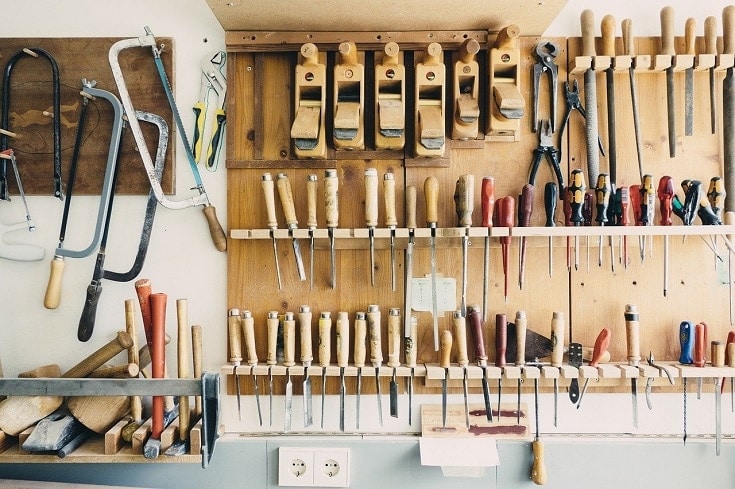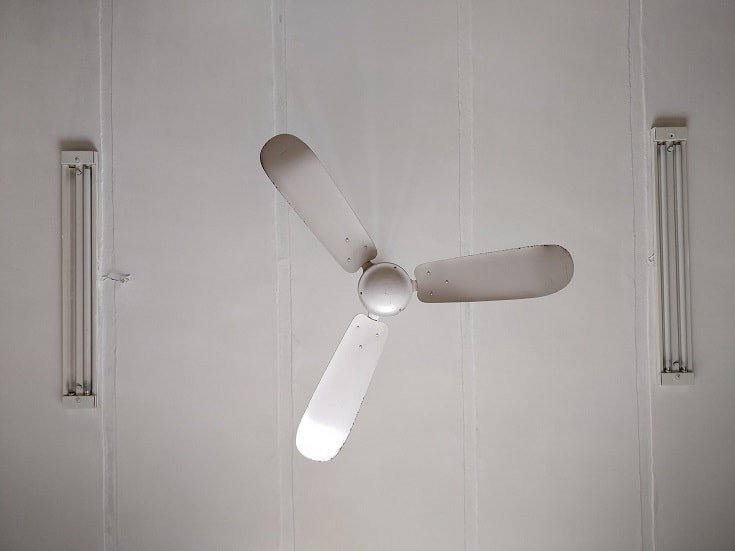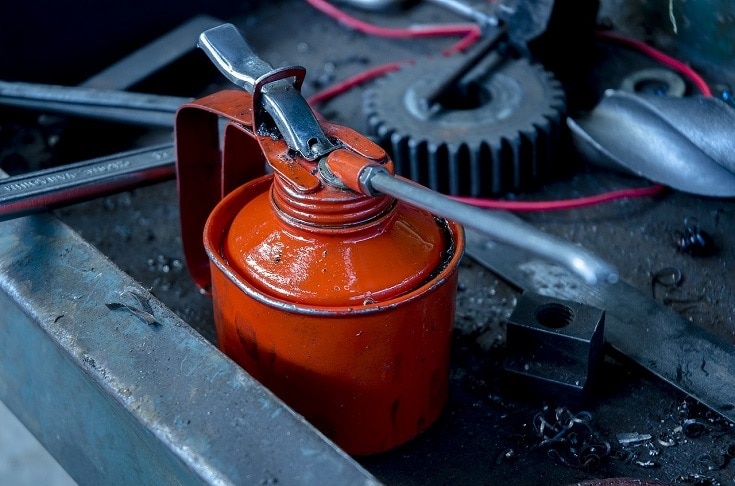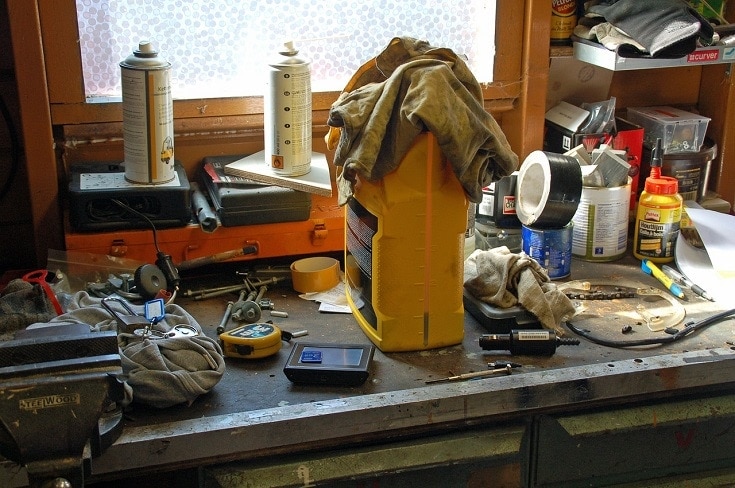7 Effective Tips to Keep Your Tools From Rusting
-
- Last updated:


Rust is the enemy of tools the world over, and as anybody who likes to spend time working around the house or building in their shed knows, good tools are an expensive investment. In the workshop, where many tools are made from metal, oxidation can be a real nuisance, and if they’re not cared for properly, even the best-quality metal tools will quickly rust.
Water is the enemy of tools, and rust will form on metal surfaces at the first sign of moisture. Fortunately, you can do several simple things to keep your tools from rusting.

The 7 Effective Tips to Keep Your Tools From Rusting
1. Control Humidity

Moisture in the air is a significant cause of rust, and if you live in an area with a humid climate, you can be certain that if you will have a problem with rust. While you can’t change the weather, you can take simple steps to reduce the impact of humidity on your tools.
Ensure adequate airflow
Tools kept in stuffy, completely enclosed workshops are far more likely to be affected by moisture in the air. Obviously, it is not possible to keep your workshop’s windows and doors always open, but you should ensure that you air out your workspace whenever you can. It is also important to ensure that there is plenty of ventilation built into your workshop’s design so air flows through even when you’re not there to open everything up.
Consider installing a fan or dehumidifier
Sometimes it’s not possible to get natural airflow through your workshop. In those cases, you may want to consider a fan for mechanical ventilation, or if you live in a particularly humid area, a dehumidifier could be a good addition to your shed.
Of course, with these types of solutions, it is important to remember that they are only effective if they are used, and you may find that the cost of running a fan or dehumidifier can, in the long term, become an expensive exercise.
2. Control Temperature
Large and quick drops of temperature in your workshop can create significant amounts of condensation on tool surfaces, more so with tools made from thick, heavy metal. For this reason, many people set their workshop up in places such as their basement, where the temperature can be maintained at a constant level and large temperature fluctuations can be avoided.
Of course, it is also possible to employ mechanical ventilation in the form of a heating or air conditioning system to maintain a constant temperature. Still, as with installing a dehumidifier, this option can become expensive over time.
3. Use Your Tools Frequently
It may sound overly simple, but using your tools frequently can help keep them free of rust. Tools left to sit and collect dust and moisture are much more susceptible to rust than those used regularly. If you wipe down and clean your tools each time you use them, this will also help keep them rust-free.
4. Keep Your Tools Clean and Well-Maintained

One of the best and most obvious ways to ensure that your expensive tools stay free from rust is to not put them away wet or covered in moisture containing dirt or sawdust.
It generally only takes a few minutes to wipe down your hand tools and benches, brush off your power tools, and vacuum up any sawdust left at the end of the day, and these simple steps can go a long way toward preventing rust. Besides, the next time you need to use your tools, you’ll appreciate the fact that you didn’t leave them coated with grime.
The concept of keeping your tools clean should also extend to any draws, toolboxes, or benches that you use to store your tools. For example, there is little point in wiping down your hand tools just to put them in a workbench drawer that has a coating of moisture-rich sawdust on it or into a toolbox containing a handful of damp soil.
Tips for maintaining hand tools
- Wipe them down: Whenever you finish using your hand tools, take a few moments to wipe them down with a clean rag. Ensure that any soil, sawdust, or other debris are removed before you put them away.
- Check for corrosion or damage: Before putting a hand tool away, it’s a good idea to give it a good look over to ensure that there is no damage or corrosion. If you notice any rust starting to form, make sure it’s removed before putting it away. If you find any other damage, set the tool aside to repair or replace it so it is in good working condition the next time you need it.
- Lubricate your tools regularly: Once you’ve inspected the tool and are satisfied that it isn’t damaged, take a moment to lubricate any moving metal parts with a product like WD-40. You may also want to spray your other metal tools too, ensuring that no oil or lubricant gets on the wooden or plastic handles. An old rag can be used to wipe away any excess lubricant.
Tips for maintaining power tools
- Wipe them down after every use: It is important to clean down your power tools every time you use them, to ensure that no sawdust, grass, soil, or other moisture-containing debris remains on the accessible metal surfaces while your tools are in storage.
- Give them a regular thorough clean: It is not always possible to thoroughly clean your power tools every time you use them, as some tools have hard-to-reach places that can only be accessed when guards or covers are removed. However, it is important to regularly take the time to remove these and clean your tools thoroughly.
- Inspect them for damage: As with your hand tools, it is important to inspect your power tools for corrosion or damage before you put them away. There is nothing worse than needing to use a tool and finding it damaged when you pull it out, so ensure that you remove any rust, repair any damage, or replace any broken parts before putting it away.
- Lubricate your tools regularly: Some power tools need lubricating oil, and it is important to ensure that this is topped up before use. It is also a good idea to regularly lubricate all the moving parts of your power tools to ensure they work as they should and don’t cease up.
- Look after your batteries: If you have battery-powered tools, they must be allowed to fully recharge and are regularly used to full discharge. Some charging packs have a discharge function that will completely discharge your battery before recharging it, and you should use this every couple of weeks to ensure that you get the longest life out of your power tool batteries.
5. Avoid storing tools on your workshop floor
Many people store their large and expensive garden tools, such as lawnmowers, edgers, and blower-vacs, on the cold floor of their workshop, and just as many keep their shovels and rakes standing on the cold and damp concrete floor in the corner of the shed. So, it is little wonder that these gardening tools often end up suffering the most from rust.
If possible, these tools, like all your other tools, should be stored in a manner that ensures that they are off the floor. One of the best ways to do this is to hang these tools from the sidewalls of your workshop.
6. Use Vapor Control Inhibitor Products
Vapor control inhibitor products work by giving off an odorless vapor that forms a protective film over your tools’ metal parts. This is a highly effective and inexpensive method of keeping rust at bay.
These products come in a variety of different forms, from small tag-like capsules that you put in your toolbox to liners that can be put in your workbench drawers and clip-lock-style plastic bags that have been treated by the inhibitor chemicals and prevent dust or other grime from settling on your hand tools.
Another similar yet inexpensive tip is to get a few silica gel packs, similar to those that come in the box with a new pair of shoes, and drop them into your toolbox.
7. Coat your tools with oil or wax

It is also possible to coat your tools in a non-oxidizing oil, such as mineral oil, or even give them a quick spray and wipe-down with some WD-40. This method is simple and effective and extremely cheap and easy to maintain. That said, keep in mind that these oils will attract and trap dust.
Paste wax can also be applied to metal surfaces and then carefully buffed. The wax will feel a little tacky at first, but with a bit of effort, buffing the surface will soon smooth this out, and unlike oils, buffed wax paste wax-coated tools won’t be dust magnets.
Featured Image Credit: Free-Photos, Pixabay
Contents

